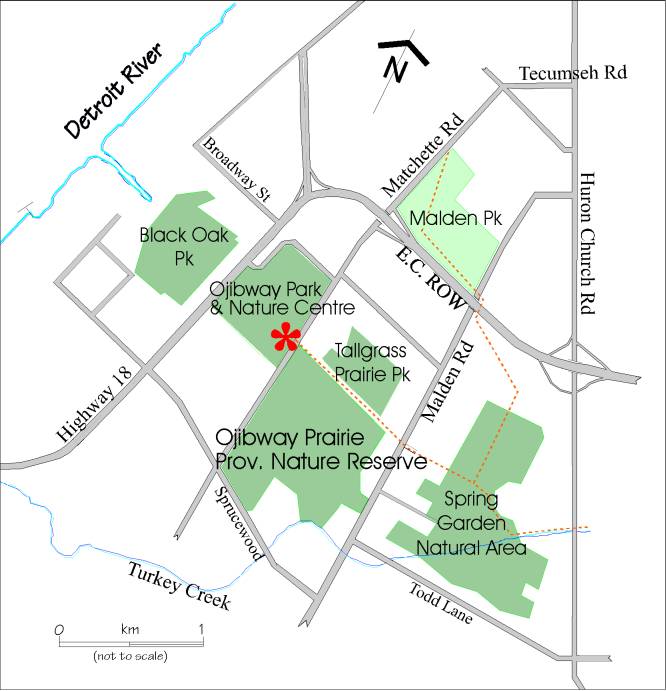Brownfield Conversion Indicator
Objective C6: Acquire or Transition Additional Lands for Integration into our Parks, Natural Areas and Natural Heritage System
The following actions are needed to complete this objective:
- Actively seek out opportunities to increase and protect parkland, natural areas and naturalized spaces, especially in locations where there is a deficit in the amount of green space.
- Work with the Essex Region Conservation Authority, community associations, school boards and residents to restore, expand and enhance natural heritage features and functions of public and private property.
- Set acquisition targets for parks and natural areas. In particular, the remaining unprotected natural areas within and around the Ojibway Prairie Complex and South Cameron Natural Area.
- Increase the amount of naturalized areas within parks.
- Source funding opportunities to secure lands.
These indicators show the progress the City is making to achieve this objective:
- Natural areas percent coverage
- Designated natural heritage land
- Amount of maintained and natural parkland
Natural Areas Indicator
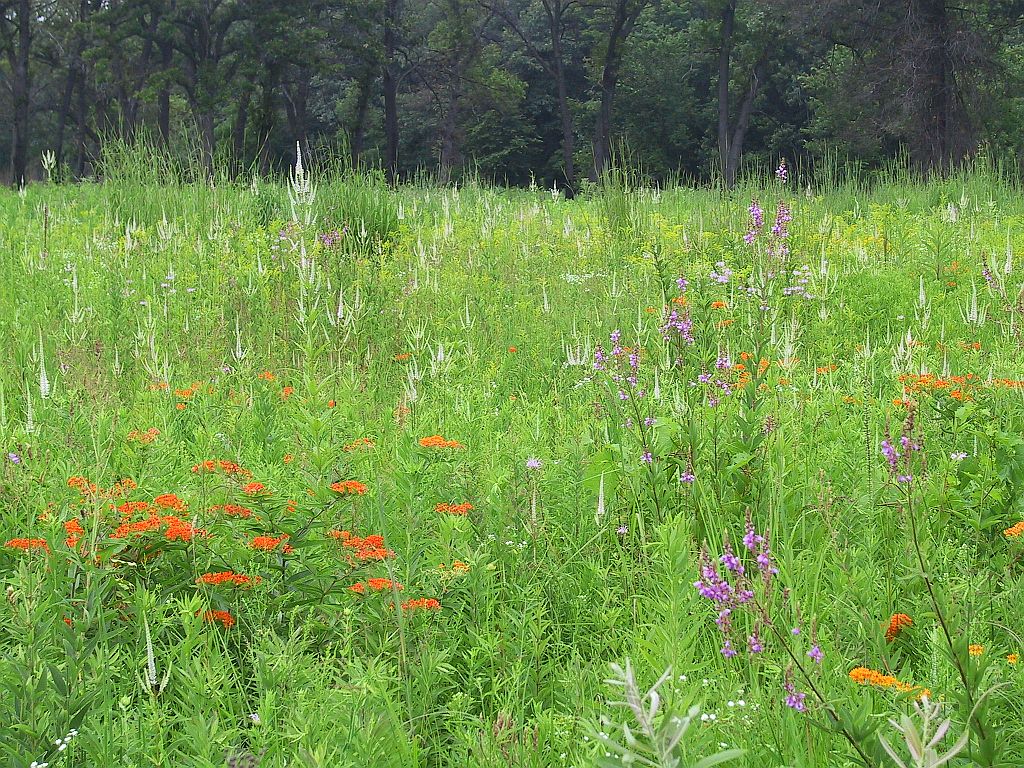
Natural areas are critical to human and environmental well-being. Natural areas perform a number of important ecological functions, including the following:
- Containing natural features and ecological functions that are important to the environmental quality and integrity of the Natural Heritage System
- Providing important ecological functions and having an age, size, site quality, and diversity of biological communities and associated species that is uncommon for the area
- Playing an important role in the provision of a balanced distribution of open space amenities and passive recreational opportunities across the urban area
- Providing significant habitat for many species, including endangered or threatened species, as well as containing distinctive, unusual or high quality natural communities or landforms
- Potentially affecting both water quantity and quality by reducing the intensity and volume of stormwater runoff and decreasing soil erosion and flooding, while also removing nutrients, sediments and toxins from surface and sub-surface flows
- Helping to keep water temperatures cool by providing shade to areas adjacent to water bodies, helping to maintain high quality habitat for desirable fish species
- Possibly also contributing to the protection of groundwater recharge areas (e.g. wooded swamps).
The percentage of natural areas is one indicator of the city's ecological integrity. Natural areas include all forest, wetland and prairie features larger than 0.5 hectares (1.25 acres) but do not include parks, lawns and other intensively managed areas.
The management of natural areas and the maintenance of their ecological integrity is an important function within an urban context. However, natural areas present many challenges because of pressure from adjacent developments and recreational uses.
Since European settlement, about 70 percent of Ontario's wetlands south of the Canadian Shield have been lost to development, with forests suffering from the most significant decline of any major southern Ontario ecosystem. The Quebec-Windsor corridor is home to intense urbanization and home to almost half of Canada's known threatened or endangered species.
How are we doing?
The Essex Region Conservation Authority (ERCA) keeps an inventory of the Natural Area coverage for the ERCA Watershed (Windsor and most of Essex County). Natural Area includes forest, wetland and prairie features. ERCA's strategic plan goal is to have 12 percent natural area coverage across the ERCA Watershed by 2020.
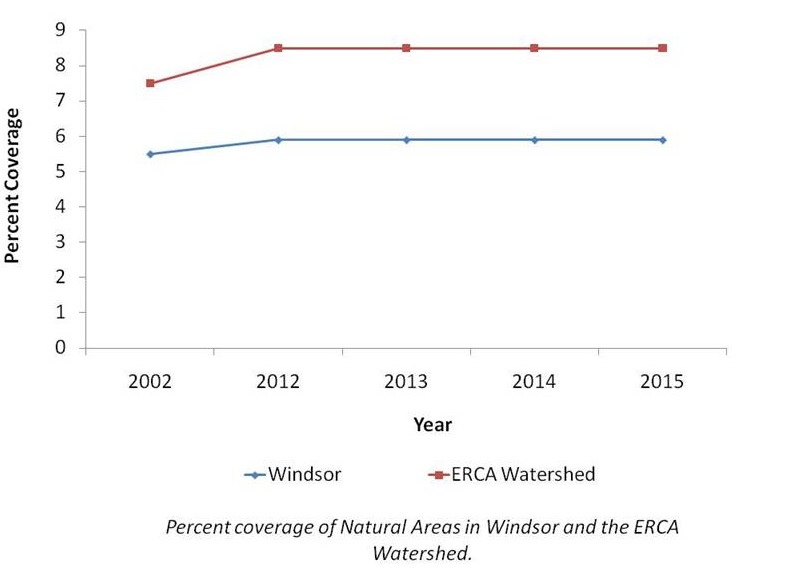
As shown in the chart above, the natural areas percent coverage in both the City of Windsor and the ERCA watershed has increased slightly since 2002. Note: Windsor 2002 data based on the Biodiversity Conservation Strategy Report (BCS), ERCA 2002. ERCA Watershed 2002 data based on ERCA Board of Directors Report FA 48/02. All other data is from the Essex Region Natural Heritage Strategy Study (ERNHSS), ERCA 2012/13.
What's the City of Windsor doing to protect our Natural Spaces?
- The City's Official Plan is currently under review. The revised Official Plan will include policies for greenway system protection and enhancement, including a complete Natural Areas Policy Review.
- The City introduced By-Law #231-2005 to protect Natural Environment Areas in the City of Windsor. It is a by-law to protect natural areas regardless of ownership status (public/private). Natural Environmental Areas include Environmental Policy Areas, Natural Heritage, and Candidate Natural Heritage Sites. This by-law covers the protection of trees and natural vegetation that includes woodlands, prairies and wetland areas.
- A Property Standards By-law 3-2006 (see By-laws Online) now includes naturalized areas and no longer requires mowing of these areas. However, there must be a buffer strip containing trimmed grass or ground cover. This encourages property owners to naturalize pieces of their property where applicable.
- In 2010, a native wildflower demonstration garden was planted at the Lou Romano Water Reclamation Plant. The native wildflowers provide a beautiful forefront to the treatment plant while saving the City money, as the area does not need to be watered or mowed. Many environmental benefits were achieved, such as water conservation and increased biodiversity.
- As part of the Grand Marais Drain Improvements, natural habitat features will be created through the planting of trees and shrubs and the installation of rock structures that would benefit both animal and plant species.
What can you do to protect our Natural Areas?
- Support local natural areas' protection initiatives through volunteering or donations.
- Join a local community group or conservation organization.
- Attend and participate in municipal planning meetings regarding natural areas.
- Get to know the natural areas in Windsor.
Natural Heritage Indicator
Natural Heritage Lands
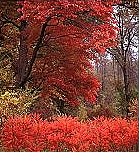
Natural Heritage lands provide for the protection and conservation of Windsor's most environmentally significant and sensitive natural areas, including provincially designated areas of natural and scientific interest (ANSI) and wetlands. Natural Heritage lands are similar to Natural Areas with the exception that Natural Heritage Lands are designated as such in the City of Windsor's Official Plan. There is overlap between the areas designated as natural heritage lands and natural areas, as some natural areas may not be designated as Natural Heritage Lands.
What's the City of Windsor doing to protect our Natural Heritage Spaces?
[Click map to enlarge.]
- The City's Official Plan is currently under review. The revised Official Plan will include policies for greenway system protection and enhancement, including a complete Natural Areas Policy Review.
- The City introduced By-Law #231-2005 to protect Natural Environment Areas in the City of Windsor. It is a by-law to protect natural areas regardless of ownership status (public/private). Natural Environmental Areas include Environmental Policy Areas, Natural Heritage, and Candidate Natural Heritage Sites. This by-law covers the protection of trees and natural vegetation that includes woodlands, prairies and wetland areas.
What can you do to protect our Natural Heritage Areas?
- Support local natural areas' protection initiatives through volunteering or donations.
- Join a local community group or conservation organization.
- Attend and participate in municipal planning meetings regarding natural areas.
- Get to know the natural areas in Windsor. The largest network of natural heritage sites in Windsor includes the Spring Garden Natural Area, the Ojibway Park complex and Black Oak Park (click the thumbnail on the right for a full-size map). A very good source of information is available on the Ojibway Nature Centre website.
Maintained and Natural Parkland Indicator
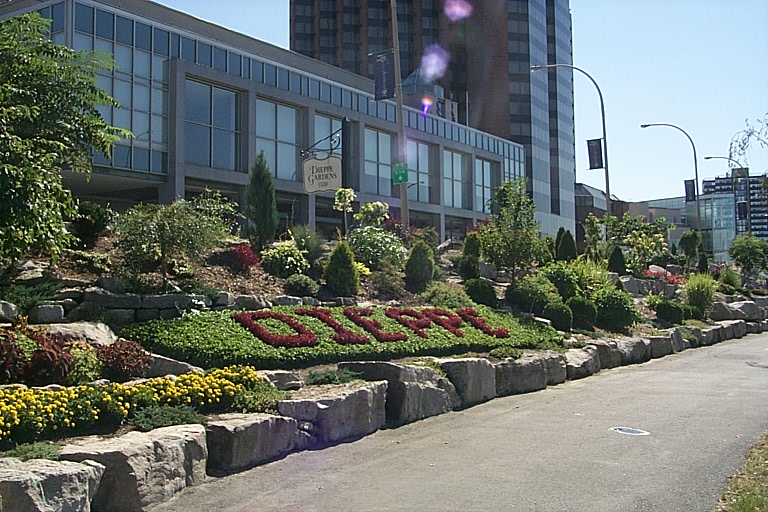
The City of Windsor takes great pride in our park systems, which include natural heritage areas and maintained parkland. The vast amount of parkland available to the residents provides opportunities for recreational activities like walking, biking and playing in our playgrounds, sport fields and trails but also allows for interaction and sharing of land between humans and nature.
How are we doing?
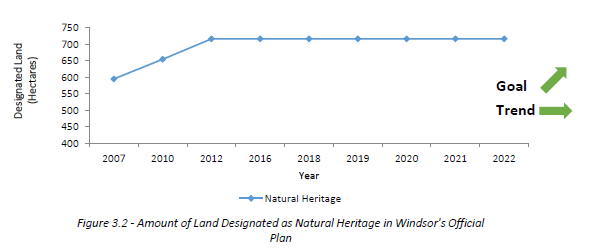
As shown in the chart above, the amount of maintained and natural parkland available for Windsor residents has increased since 2007 and has remained constant since 2012.
Note: Provincially Significant Wetlands that were removed during Herb Gray Parkway Construction have not been replaced.
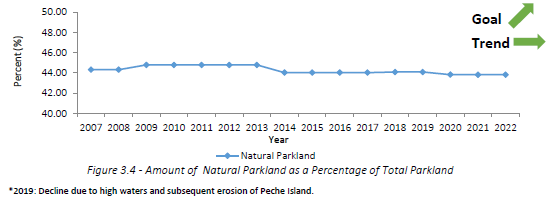
As shown in the figure above, the percentage has remained relatively constant since 2014, with a slight decline in 2020 that has remained into 2022.
Note: 2019: Decline due to high waters and subsequent erosion of Peche Island
What's the City of Windsor doing to expand the amount of parkland available?
- The City's Official Plan is currently under review. The revised Official Plan will include policies for greenway system protection and enhancement.
- The City introduced By-Law #231-2005 to protect Natural Environment Areas in the City of Windsor. It is a by-law to protect natural areas regardless of ownership status (public or private). Natural Environment Areas include Environmental Policy Areas, Natural Heritage, and Candidate Natural Heritage Sites. This by-law covers the protection of trees and natural vegetation that includes woodlands, prairies and wetland areas.
- The Parks and Recreation departments provide residents and visitors with approximately 2,527 acres of green space within 202 parks, featuring gardens, monuments, over 34 sculptures, numerous fountains, playing fields and picnic areas. These departments are also responsible for beautification efforts, such as planting formal gardens, boulevards and the riverfront with thousands of flowers, plants, and shrubs.
What can you do to help?
- Enjoy the parks!
- Visit Ojibway Nature Centre to learn first hand the benefits of protecting these remaining natural areas.
- Become involved in parks development by attending public open houses and providing comments.
For more information on Environmental Initiatives
Email: emp@citywindsor.ca

